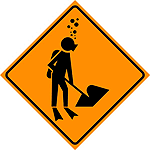|
| |

|
|
| < Prev. month |
Next month > |

|
This page under construction.
Here are some of the topics that will be covered in this chapter. More text and images will eventually be added to this section. Thank you for your patience.
|
- By October giant kelp is having a tough time, as coastal water contains very little nutrients and the days are becoming shorter. Many kelp blades begin to turn yellow and tattered due to grazers and begin to rot, or are heavily encrusted by "epiphytic" algae and bryozoans. This process occurs in early fall in the most protected coastal areas, but by October, affects kelp in exposed areas as well.
- As the kelp canopy thins, understory brown algae such as Laminaria and Pterygophora put on a late growth spurt, reach maximum lushness, and begin releasing spores.
- Annual brown algae such as bull kelp, oar weed, and sea palm, also begin to release spores.
- Blue rockfish mate In the kelp beds. The young will develop inside their mother's bodies until being released as larvae in January.
- Two of the most important predatory fish of the kelp-beds, kelp greenling and lingcod, lay and guard clusters of eggs in rocky nearshore areas (such rocky areas are relatively abundant, since most of the sand is on the beach at this time of year). Another kelp-bed predator, the Cabezon, lays its nests of eggs closer to shore, in lower intertidal areas.

|
|
